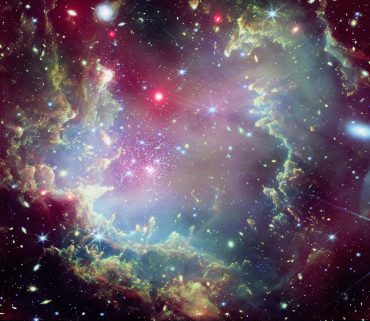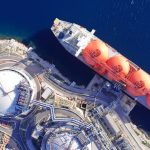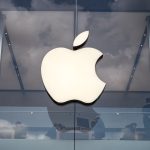

Webb’s Advanced Instruments Detect Atmospheric Water Vapor and Key Chemical Markers on Massive Ocean World K2-18 b
Three Key Facts
- K2-18 b is located 120 light-years away and measures more than twice Earth’s size, displaying a hydrogen-rich atmosphere similar to gas giants
- The James Webb Space Telescope detected significant traces of methane and carbon dioxide in the planet’s atmosphere, suggesting a possible vast ocean beneath
- The exoplanet orbits within the habitable zone of a red dwarf star, indicating potential conditions for liquid water to exist
Introduction
Scientists have identified atmospheric signatures on a distant exoplanet that could reshape our understanding of potentially habitable worlds. K2-18 b, an exoplanet more than twice Earth’s size located 120 light-years away, exhibits a hydrogen-rich atmosphere with chemical markers that suggest the presence of liquid water.
This discovery represents a significant advancement in exoplanet research, particularly in identifying worlds that might support life despite being fundamentally different from Earth. The planet’s unique atmospheric composition provides new insights into the diversity of potentially habitable environments throughout the galaxy.
Key Developments
NASA’s James Webb Space Telescope enabled researchers to analyze K2-18 b’s atmospheric composition with unprecedented precision. The observations revealed significant concentrations of methane and carbon dioxide, chemical signatures that indicate complex atmospheric processes occurring on the distant world.
According to Google News, the exoplanet lies within the habitable zone of its star, positioning it at an optimal distance where liquid water could potentially exist on its surface. This positioning, combined with the atmospheric data, creates compelling evidence for studying the planet’s potential habitability.
Researchers from NASA’s Jet Propulsion Laboratory contributed to the comprehensive analysis of the planet’s atmospheric characteristics. Their work demonstrates how advanced space telescopes can detect and analyze atmospheric components across vast cosmic distances.
Market Impact
The successful detection of atmospheric signatures on K2-18 b validates the capabilities of next-generation space telescopes and their role in exoplanet research. These findings demonstrate the return on investment in advanced astronomical instruments, supporting continued funding for space-based observation programs.
The discovery influences the broader space exploration industry by providing concrete targets for future missions and research initiatives. Space agencies and private companies now have specific examples of potentially habitable worlds that warrant continued investigation and technological development.
Research institutions benefit from access to high-quality data that advances our understanding of planetary formation and atmospheric evolution. This knowledge base supports academic programs and attracts talent to fields related to astrobiology and planetary science.
Strategic Insights
K2-18 b orbits a red dwarf star, the most common type of star in our galaxy, suggesting that similar planets might be widespread throughout the cosmos. This observation indicates that potentially habitable worlds might be more common than previously estimated, particularly around smaller, cooler stars.
The planet’s thick, hazy atmosphere presents both opportunities and challenges for future observations. While the atmospheric density complicates direct surface observations, it provides rich data about atmospheric chemistry and dynamics that inform our understanding of planetary environments.
The detection methods used for K2-18 b establish protocols for analyzing other exoplanets with similar characteristics. These techniques can be applied to a growing catalog of discovered exoplanets, expanding our knowledge of potentially habitable worlds.
Expert Opinions and Data
Dr. Nikku Madhusudhan, an astronomer at the University of Cambridge, emphasizes the broader implications of this research. “This discovery is crucial in our quest to understand the nature of habitable environments beyond Earth,” he states, highlighting how such findings expand our conception of where life might exist.
The atmospheric analysis reveals that K2-18 b possesses characteristics that differ significantly from Earth while still maintaining conditions that could support liquid water. This finding challenges traditional models of habitability that focus primarily on Earth-like conditions and atmospheres.
The planet’s hydrogen-rich atmosphere resembles those found on larger gas giants, yet its size and orbital position suggest it might maintain surface conditions suitable for liquid water. This combination of features represents a new category of potentially habitable worlds that researchers are beginning to identify and study.
Conclusion
The atmospheric analysis of K2-18 b demonstrates significant progress in identifying and characterizing potentially habitable exoplanets. The detection of methane and carbon dioxide, combined with the planet’s position within its star’s habitable zone, provides compelling evidence for continued investigation of this distant world.
These findings expand our understanding of planetary diversity and the range of conditions that might support life. The success of this research validates current observational techniques and establishes a foundation for analyzing similar exoplanets throughout the galaxy.








